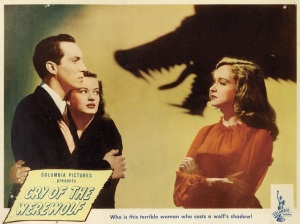Private detective Philip Marlowe (Dick Powell) is hired by dim-witted, hulking, ex-con Moose (Mike Mazurki) to find “his Velma.” He’s also hired for a one night body guard job that ends up with his client dead, the killing somehow connected to a stolen jade necklace belonging to the Grayle family: ingénue daughter Ann (Anne Shirley), father Leuwen (Miles Mander), and stepmother femme-fatale Helen (Claire Tevor). The two cases are connected through Jules Amthor (Otto Kruger), a quack doctor.
Raymond Chandler wasn’t happy with the messy way Hollywood had used his novels, taking his plots but dropping the main character and replacing him with The Falcon and then detective Michael Shayne. He wanted to get out of town, but RKO already had the rights to Farewell My Lovely. Edward Dmytryk was tired of 3rd rate productions and wanted a chance to prove himself. Dick Powell was too old for the boyish roles he was known for and had wanted to get away from musicals and take on tough-guy roles for years. Claire Trevor had been on the edge of the A-list, playing good girls, but her stock was dropping fast and she needed a new image. Chandler hated the notion of a dancer playing his private eye, almost as much as Dmytryk hated it. And all four ended up happy. Trevor and Powell got new careers, Dmytryk got his chance, and Chandler was happy with a proper representation of Marlowe, at least for two years until Bogart became the definitive Marlowe in The Big Sleep. The title Farewell, My Lovely confused movie-goers who assumed it was another Dick Powell musical so it was renamed Murder, My Sweet, and they sold tickets, making the studio happy too.
The story is as convoluted as Chandler’s stories normally are (try working out The Big Sleep some time), which is a minor advantage. You won’t figure it all out in the first reel. And the high contrast photography has that marvelous Film Noir feel. But the star of the show is the dialog: Chandler’s or Chandler-like. Chandler was a master of elaborate lines structured with his invented slang and somehow making it sound like something an uneducated man would say, at least if he existed in a world far wittier than ours.
World class dialog can be a mixed blessing as it becomes noticeable when the execution is only average. And that’s the problem with Murder, My Sweet. Dmytryk was a competent director, but nothing special. He’d no artistry to elevate the material. And Powell? Like the director, Powell is fine. He doesn’t embarrass himself. He should come off as a bit tougher, but that’s not a major issue. But he’s flat. There’s no spark. Twenty other actors could have done the same and be equally “fine.” In the mouth of Bogart (and with the aid of Billy Wilder or Howard Hawks), the lines would have made this a masterpiece. But with Powell, it’s…fine.
In addition to this film and the ’46 The Big Sleep, Marlowe has appeared in numerous films, most of which it is fine to skip: Lady in the Lake (1946), The Brasher Doubloon (1947), Marlowe (1969), The Long Goodbye (1973), Farewell, My Lovely (1975), The Big Sleep (1978).






 At a horror museum, while the tour guide (John Abbott) gives speeches on werewolves, Doctor Charles Morris (Fritz Leiber)—doctor of…history maybe, or voodoo—researches a werewolf woman. He’s murdered, seemingly by a wolf, and his scientist son (Stephen Crane) and the son’s semi-sister/girlfriend (Osa Massen) play detective to find the murderer. Police detective (Barton MacLane) also plays detective. Is the murderer human or werewolf, and is it the gypsy queen (Nina Foch), the janitor (Ivan Triesault), or the guide?
At a horror museum, while the tour guide (John Abbott) gives speeches on werewolves, Doctor Charles Morris (Fritz Leiber)—doctor of…history maybe, or voodoo—researches a werewolf woman. He’s murdered, seemingly by a wolf, and his scientist son (Stephen Crane) and the son’s semi-sister/girlfriend (Osa Massen) play detective to find the murderer. Police detective (Barton MacLane) also plays detective. Is the murderer human or werewolf, and is it the gypsy queen (Nina Foch), the janitor (Ivan Triesault), or the guide?
